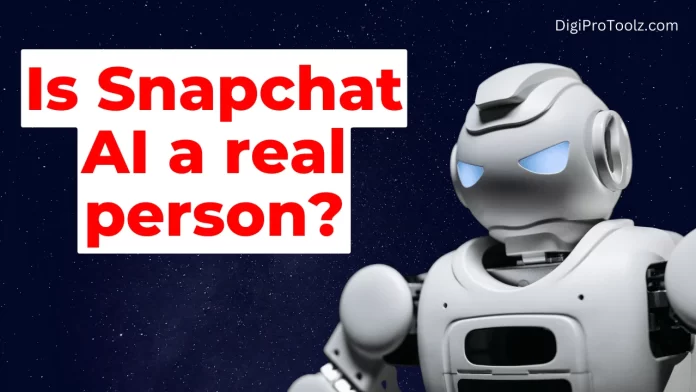Artificial intelligence (AI) has become a revolutionary force in the ever-changing world of social media, completely changing the way users communicate and engage with each other. Leading this change are platforms like Snapchat which leverage AI technologies to improve user experience. My AI sticks out among these developments as a particularly fascinating addition to Snapchat’s feature set.
AI on Snapchat: An Overview
Snapchat’s new feature, My AI, is a major advancement in the use of AI in social media. It works as an AI chatbot that is intended to communicate with users in a way that seems human. My AI, which is based on OpenAI’s advanced GPT technology has generated interest and inquiries from users especially about its nature and potential.
Character of My Snapchat AI
My AI is an artificial intelligence system designed to converse with Snapchat users; it is not a real, live person. The purpose of an AI chatbot is to provide individualized answers and support, creating the sense that a real person is speaking with you. It’s important to stress that My AI is a computer program that uses machine learning models and algorithms; it is not a sentient entity.
My AI’s Technology: GPT and Machine Learning
It’s essential to learn about the technology behind My AI in order to comprehend its capabilities. The cutting-edge language model created by OpenAI, GPT (Generative Pre-trained Transformer), is the foundation of my AI.
With the help of GPT, a miracle of machine learning, the chatbot can produce language that appears human because it is trained on patterns and data.
The modifications and improvements made to this technology make My AI’s interactions more sophisticated and context-aware. But it’s crucial to keep in mind that My AI is still fundamentally an AI software and not a sentient entity with feelings or conscience.
My AI and Human-like Interactions

The progress made in conversational AI is demonstrated by my AI’s capacity to hold human-like discussions with users. It has the ability to comprehend and react to text inputs in a way that mimics genuine human communication. This involves responding to inquiries, making recommendations, and even striking up a conversation informally.
My AI’s Delusion of Human Intelligence
The distinction between artificial and human intelligence is frequently muddled by my AI’s surprising human-like answers. It can simulate understanding, empathy, and comedy to create a conversational experience that consumers find interesting and relatable. But it’s crucial to understand that this “intelligence” isn’t actually human cognition; rather, it’s the product of training and programming.
My AI’s Limitations in Simulating Human Conversations
My AI is not like real people in that it has limitations despite its amazing capabilities:
Lack of Emotional Understanding:
My AI might find it difficult to recognize and react appropriately to the nuanced emotions and complex feelings of people.
Lack of Experience:
Three essential components of human interactions—emotions, empathy, and consciousness are absent from my AI.
Algorithmic Nature:
My AI does not draw from real-world experiences or emotions in its replies; instead, it draws from patterns found in the data it has been trained on.
Even though My AI provides a great conversational experience, it’s critical to recognize these differences in order to keep a clear picture of the interactions occurring in the digital sphere.
My AI’s User Experience
Personalizing user interactions is one of My AI’s most impressive features. To customize responses, complex machine learning algorithms examine user inputs and actions in the background. Conversations with My AI feel interesting and pertinent to each individual because of this customisation.
The chatbot’s learning algorithms are activated as long as people interact with My AI. My AI adjusts its responses based on user choices and previous conversations, gaining knowledge from every connection. This process of dynamic learning helps create the appearance of meaningful talks with a sentient being.
How to Tell My AI Apart from Actual People
Although my AI is quite good at mimicking human speech, there are some important features that can help consumers tell it apart from actual people.
Consistency:
The tone and manner in which my AI responds are always the same. Real people may communicate differently depending on the situation and their emotions.
Instant Availability:
My AI is always on and ready to help. It’s possible that real individuals aren’t always available to talk.
Data Recall:
To ensure a smooth communication, my AI is able to recall a great deal of information and previous exchanges. Actual people may find it difficult to recall particular facts from earlier exchanges.
Generic Responses:
Occasionally, My AI might offer general answers that don’t have the nuance of real-world conversations. Responses from actual individuals are typically more complex and intimate.
How do users perceive my AI: is it genuine or fake?

Views of My AI among users differ greatly. For some, the experience is so compelling that My AI becomes a real conversation partner. Even though some people are well aware of its false nature they still like the ease and amusement it offers.
Users’ expectations and the caliber of their encounters with My AI frequently determine how attached and engaged they become with the platform. For a lot of people My AI is a dependable and enjoyable online friend.
Ethics in AI Development
The increasing proficiency of AI technology, such as My AI in simulating human interactions has brought ethical concerns to light. The possibility of consumers forming emotional bonds is one of the main things to take into account.
Taking Care of AI misconceptions and transparency
It is crucial for AI developers to be open and honest about the nature of AI entities like My AI in order to address ethical concerns. It is important to inform users that they are engaging with a machine and not a living. This openness aids in controlling expectations and avoiding misunderstandings.
It is imperative for AI developers to provide unambiguous protocols for AI interactions, stressing the distinctions between AI and authentic human communication. Making sure that consumers are not tricked into thinking that AI entities have feelings or past experiences is a crucial aspect of ethical AI development.
